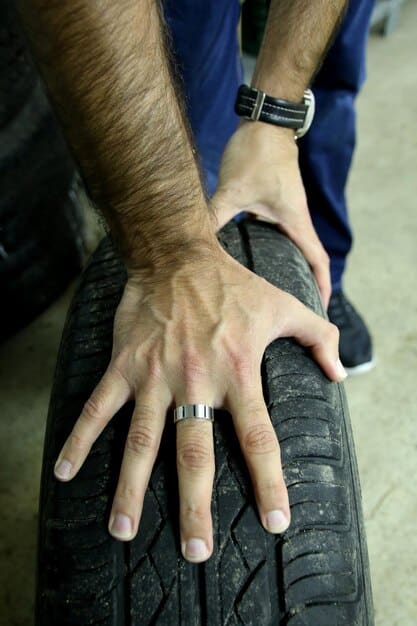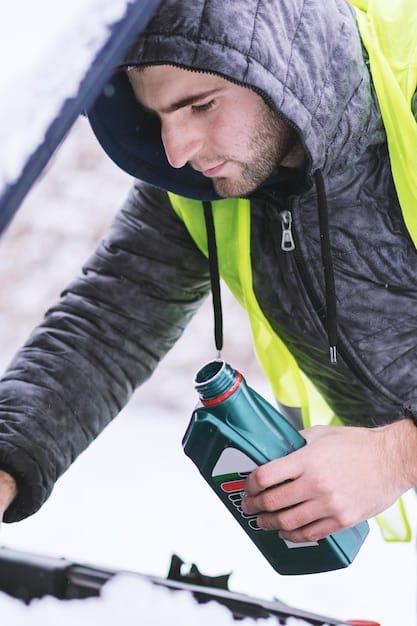Road Trip Vehicle Maintenance: 2025’s Essential Checks for Breakdowns

Road trip vehicle maintenance in 2025 requires essential checks focusing on tires, fluids, brakes, battery, and overall system diagnostics to prevent breakdowns and ensure a safe and enjoyable journey.
Road trip vehicle maintenance: essential checks to prevent breakdowns in 2025
Embarking on a road trip is an exciting adventure, but ensuring your vehicle is up to the task is paramount. Road trip vehicle maintenance: essential checks to prevent breakdowns in 2025 should be your mantra before hitting the open road, focusing on preventative measures to avoid unexpected issues and guarantee a smooth, safe journey.
Tire Inspection: Your First Line of Defense
Your tires are the only point of contact between your vehicle and the road, making their condition vital for safety and performance. A thorough tire inspection is an absolute necessity before any road trip. Neglecting this step can lead to blowouts, reduced fuel efficiency, and compromised handling.
Checking Tire Pressure
Proper tire pressure is essential for optimal handling, braking, and fuel economy. Use a reliable tire pressure gauge to check the pressure in each tire, including the spare. Inflate or deflate to match the manufacturer’s recommended pressure, usually found on a sticker inside the driver’s side door or in the owner’s manual.
Inspecting Tire Tread
Tire tread depth affects grip and traction, especially in wet conditions. Use a tread depth gauge or the “penny test” (insert a penny upside down into the tread; if you can see all of Lincoln’s head, the tread is too low) to assess the remaining tread. Replace tires with inadequate tread.
- Ensure all tires are inflated to the correct pressure.
- Visually inspect tires for cuts, bulges, or uneven wear.
- Rotate tires according to the manufacturer’s recommendations.
- Check the spare tire and ensure it is properly inflated and accessible.
Regular tire maintenance, including proper inflation, tread checks, and timely replacements, will enhance safety and prolong the life of your tires. Paying attention to these details will keep you rolling smoothly on your road trip.

Fluid Levels: Ensuring Optimal Performance
Fluids are the lifeblood of your vehicle, lubricating moving parts, cooling the engine, and enabling essential functions. Checking and topping off fluid levels is a crucial aspect of road trip vehicle preparation. Neglecting this can lead to overheating, engine damage, and brake failure.
Engine Oil
Check the engine oil level using the dipstick. The oil should be between the minimum and maximum marks. If it’s low, add the correct type of oil as specified in your owner’s manual. Also, note the oil’s color and consistency. Dark, sludgy oil indicates it’s time for an oil change.
Coolant (Antifreeze)
The coolant prevents the engine from overheating. Check the coolant level in the reservoir when the engine is cold. If it’s low, add a 50/50 mix of coolant and distilled water. Inspect the coolant hoses for leaks or cracks.
- Check engine oil, coolant, brake fluid, power steering fluid, and windshield washer fluid levels.
- Top off any fluids that are low, using the correct type for each system.
- Inspect hoses and belts for cracks, leaks, or wear.
Maintaining proper fluid levels is a simple but essential task that can prevent costly breakdowns and ensure your vehicle runs smoothly throughout your road trip. Regular checks keep everything running as it should.
Brake System: Stopping Power You Can Rely On
The brake system is arguably the most critical safety component of your vehicle. Ensuring it’s in top condition is non-negotiable before embarking on a road trip. Faulty brakes can lead to accidents and jeopardize your safety and the safety of others.
Brake Pad Inspection
Inspect the brake pads for wear. If they are thin or worn down to the wear indicators, replace them. Listen for any unusual noises, such as squealing or grinding, while braking. These can indicate worn brake pads or other brake system issues.
Brake Fluid
Check the brake fluid level in the master cylinder. Low brake fluid can indicate a leak in the system. Also, inspect the fluid’s color. Dark or contaminated brake fluid should be flushed and replaced. Replace it according to the manufacturer’s recommendations.

- Check brake pad thickness and replace if necessary.
- Inspect brake rotors for cracks or damage.
- Ensure brake fluid is at the correct level and free from contamination.
- Test the parking brake to ensure it holds the vehicle securely.
By paying close attention to your brake system and addressing any issues promptly, you’ll ensure you have the stopping power you need for a safe and stress-free road trip. This maintenance is critical for your safety and peace of mind.
Battery and Electrical System: Powering Your Journey
A healthy battery and electrical system are essential for starting your vehicle and powering all its electrical components. A weak or failing battery can leave you stranded, while electrical problems can affect everything from your lights to your engine management system.
Battery Check
Inspect the battery terminals for corrosion. Clean them with a wire brush and baking soda solution if necessary. Check the battery’s voltage with a multimeter. A fully charged battery should read around 12.6 volts. Have the battery load-tested to assess its overall condition.
Lights and Signals
Ensure all lights are working, including headlights, taillights, brake lights, turn signals, and hazard lights. Replace any burnt-out bulbs. Check the condition of the wiring and connections, looking for any damage or corrosion.
- Test the battery’s voltage and overall condition.
- Clean battery terminals and check connections.
- Inspect and test all lights, including headlights, taillights, and turn signals.
- Check the condition of wiring and connections throughout the electrical system.
Regular maintenance of your battery and electrical system can prevent many common roadside breakdowns. Keeping everything powered up means you can rely on your vehicle throughout your road trip.
Wiper Blades and Windshield: Clear Visibility Matters
Clear visibility is crucial for safe driving, especially during inclement weather. Worn or damaged wiper blades can streak and smear the windshield, reducing visibility and increasing the risk of accidents. A clean and properly functioning windshield is essential for a safe road trip.
Wiper Blade Inspection
Inspect the wiper blades for cracks, tears, or wear. Replace them if they leave streaks or fail to clear the windshield effectively. Use a windshield washer fluid that is appropriate for the season, with antifreeze protection in colder months.
Windshield Condition
Check the windshield for chips or cracks. Small chips can often be repaired, but larger cracks may require windshield replacement. Ensure the windshield is clean, both inside and out, for optimal visibility.
- Inspect wiper blades for wear and replace if necessary.
- Ensure the windshield is clean and free of cracks or chips.
- Check and refill windshield washer fluid.
Maintaining your wiper blades and windshield ensures you have clear visibility in all conditions, enhancing safety and reducing stress during your road trip. Don’t overlook these simple maintenance steps.
Essential Tools and Emergency Kit: Be Prepared for Anything
No matter how well you prepare your vehicle, unexpected issues can still arise. Carrying essential tools and an emergency kit can help you handle minor repairs and stay safe while waiting for assistance. Being prepared is key to mitigating the impact of any unforeseen problems.
Essential Tools
Include basic tools like a wrench, screwdriver, pliers, and a socket set. A tire pressure gauge, adjustable wrench, and duct tape can also be invaluable. Make sure you know how to use these tools safely and effectively.
Emergency Kit
Your emergency kit should include jumper cables, a flashlight with extra batteries, a first-aid kit, reflective triangles or flares, a basic tool kit, and a blanket. Water and non-perishable snacks are also essential.
- Assemble a basic toolkit with essential wrenches, screwdrivers, and pliers.
- Pack an emergency kit with jumper cables, a flashlight, a first-aid kit, and reflective triangles.
- Include water, non-perishable snacks, and a blanket for emergencies.
By packing essential tools and an emergency kit, you’ll be better equipped to handle minor repairs and stay safe in case of unexpected breakdowns. Being prepared can make all the difference in a challenging situation.
| Key Checkpoint | Brief Description |
|---|---|
| 🚗 Tire Inspection | Check pressure, tread depth, and overall condition. |
| 💧 Fluid Levels | Inspect and top off engine oil, coolant, brake fluid, etc. |
| 🔋 Battery Health | Check battery voltage, clean terminals, and test load. |
| 🛠️ Emergency Kit | Pack tools, jumper cables, first-aid, and reflective triangles. |
Frequently Asked Questions
▼
You should check your tire pressure at least once a month and before any long trip. Use a tire pressure gauge to ensure it’s at the recommended level.
▼
Squealing or grinding noises while braking, a vibrating brake pedal, or reduced braking performance are all signs your brake pads may need replacing.
▼
Park on a level surface, wait for the engine to cool, pull out the dipstick, wipe it clean, reinsert it fully, and pull it out again to check the oil level.
▼
Include jumper cables, a flashlight, a first-aid kit, reflective triangles, a basic tool kit, water, and non-perishable snacks to handle various emergencies.
▼
Generally, you should change your engine oil every 3,000 to 5,000 miles, but refer to your vehicle’s owner’s manual for specific recommendations.
Conclusion
Preparing your vehicle for a road trip with essential maintenance checks is a critical step in ensuring a safe and enjoyable journey. By focusing on tires, fluids, brakes, battery, and having an emergency kit, you can confidently hit the road knowing you’ve taken the necessary precautions to prevent breakdowns and make the most of your adventure.

